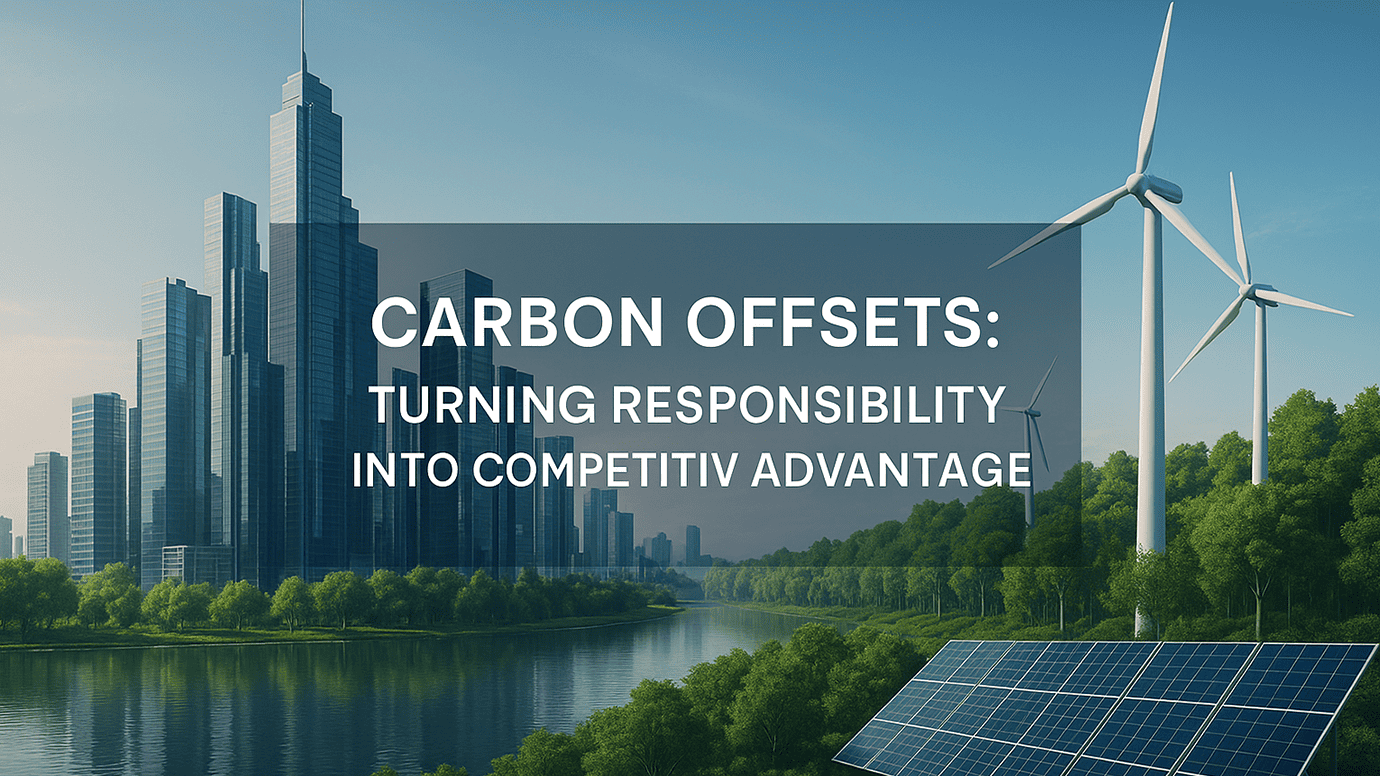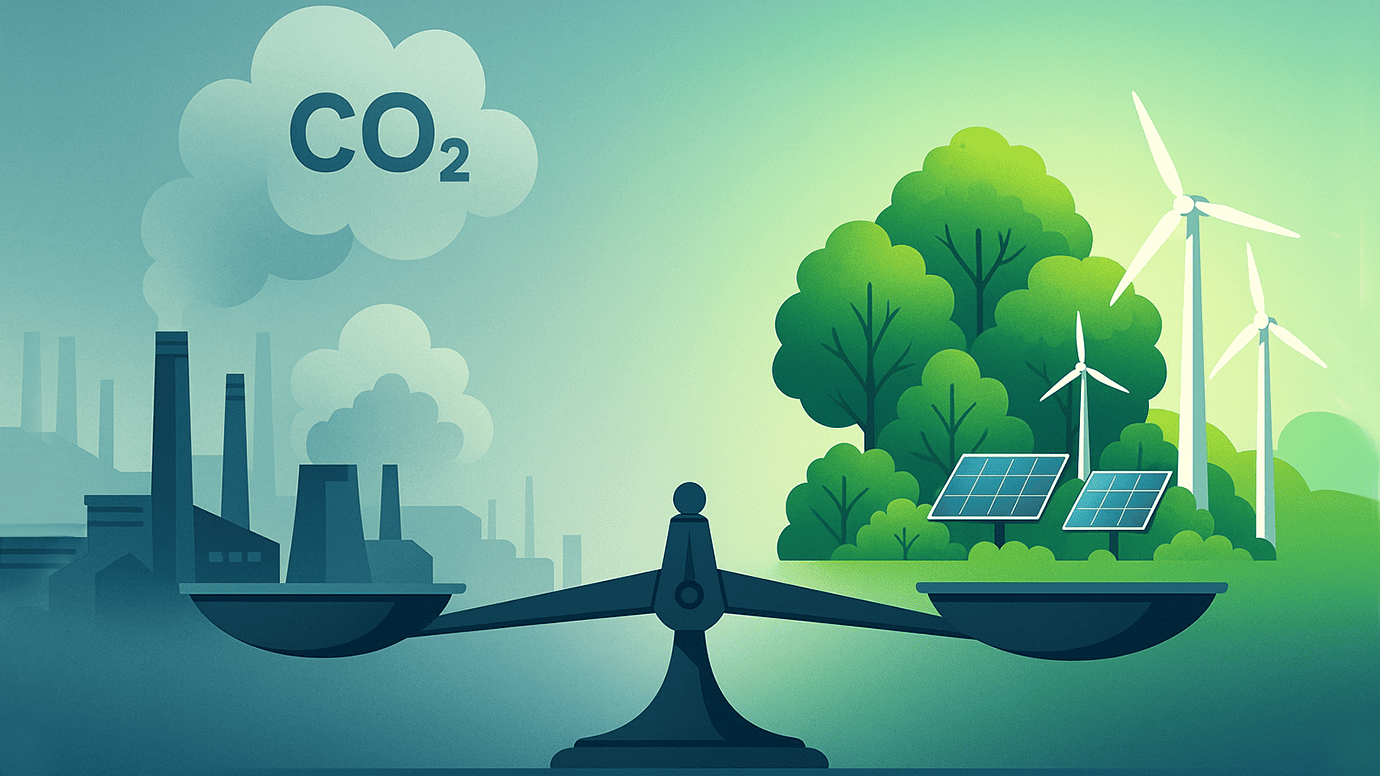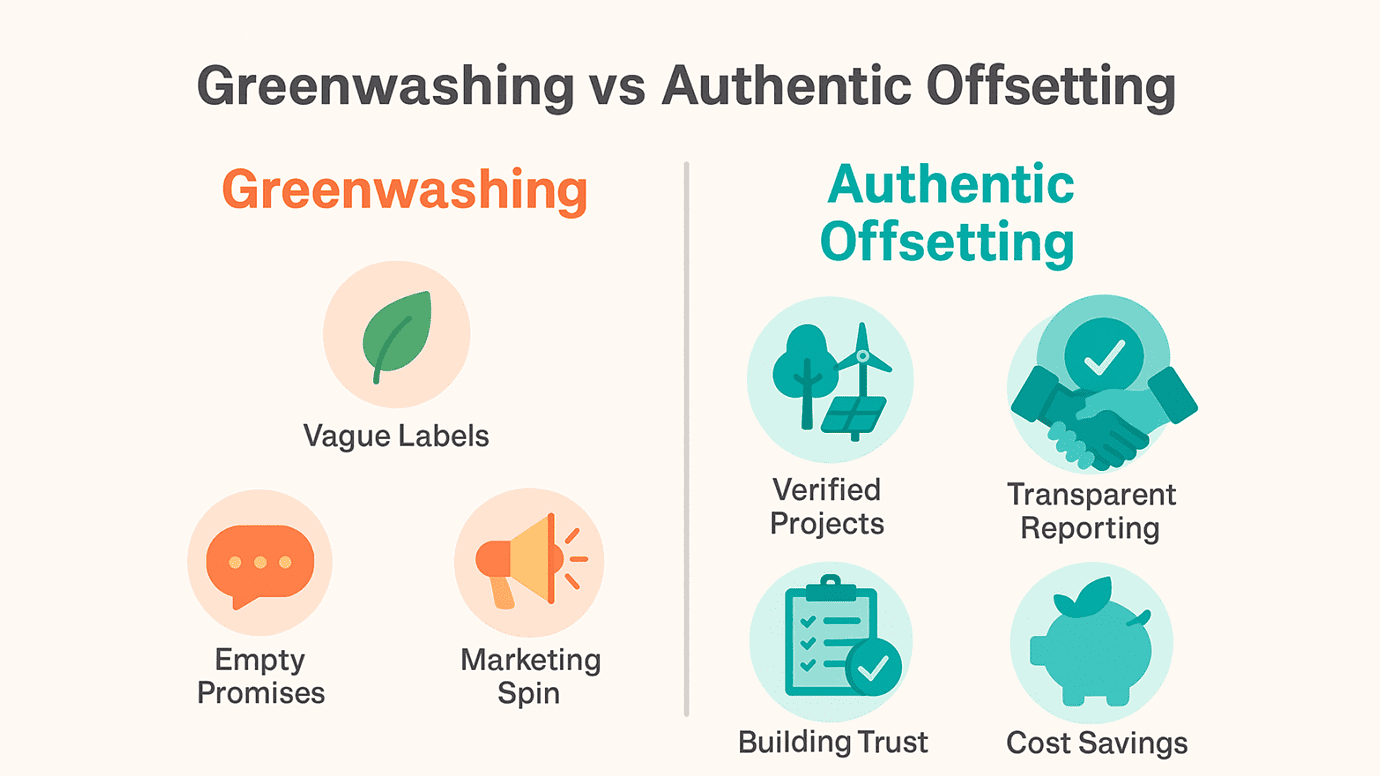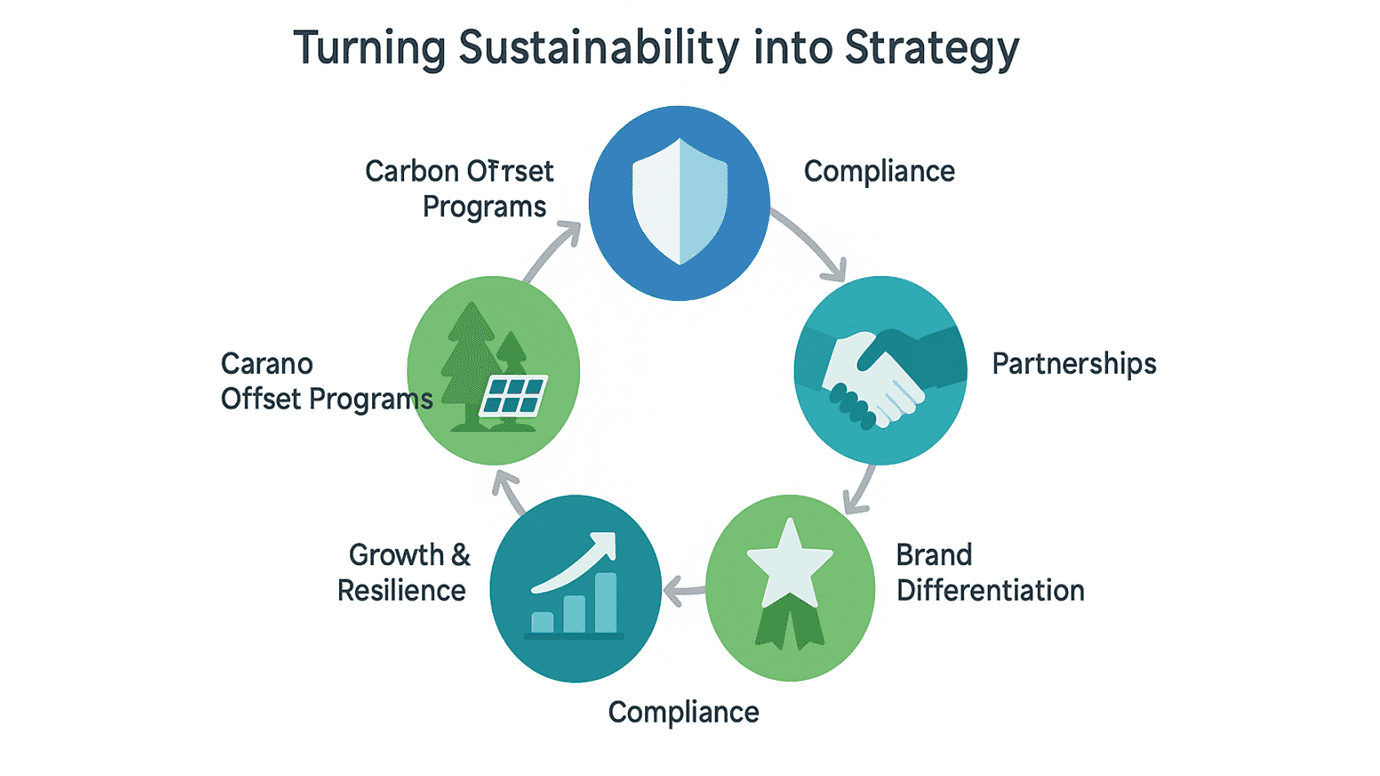Why Carbon Offsets Explained: Practical Ways to Go Green and Stay Competitive
The world is at a turning point. With global temperatures rising and environmental crises becoming more frequent, climate change is no longer
a distant threat—it’s a daily reality for businesses and communities alike. Governments, investors, and even customers are holding companies accountable for their carbon footprints, making corporate responsibility not just a moral obligation but a strategic necessity.
According to recent reports, the global carbon offset market is projected to grow exponentially, reaching hundreds of billions of dollars in the coming decades. This rapid growth is fueled by stricter regulatory pressures, net-zero pledges from corporations worldwide, and the urgent push to balance economic growth with sustainability. In other words, companies that fail to act risk falling behind in competitive, reputation, and compliance landscapes.

So, what’s the solution for businesses that want to be proactive without stalling operations? The answer lies in understanding the true meaning of carbon offset and putting it into practice. Simply put, to off set carbon is to compensate for unavoidable emissions by supporting verified carbon offset projects that either reduce or remove greenhouse gases from the atmosphere. These can include initiatives like reforestation, renewable energy, or cutting-edge carbon removal technologies.
For organizations looking to be zero carbon or move toward a carbon zero future, investing in credible carbon offset programs offers a practical, measurable, and immediate step forward. They not only help companies demonstrate climate leadership but also ensure compliance with evolving ESG frameworks and stakeholder expectations.
In this context, carbon offsets are no longer just an environmental buzzword—they are a vital business strategy. They empower companies to stay resilient, remain competitive, and turn sustainability into a growth driver rather than a cost center.
What Are Carbon Offsets?
At its core, a carbon offset is a simple yet powerful concept: one credit equals one ton of CO₂ reduced or removed from the atmosphere. This means that every time a company or individual generates unavoidable emissions, they can off set carbon by investing in activities that balance those emissions elsewhere.

The meaning of carbon offset goes beyond just numbers—it’s about taking responsibility for your carbon footprint while contributing to the fight against climate change. For example, supporting carbon offset programs can involve investing in carbon offset projects like:
- Tree planting & reforestation: Forests naturally absorb carbon dioxide, making them one of the most recognized forms of offsets.
- Renewable energy initiatives: Wind, solar, and hydro projects reduce dependence on fossil fuels and create long-term emission reductions.
- Biochar projects: Converting organic waste into stable carbon storage while improving soil health.
- Waste-to-energy plants: Turning landfill methane and waste into clean energy while cutting greenhouse gases.
These projects not only reduce emissions but also generate co-benefits—supporting communities, biodiversity, and sustainable development. That’s why businesses seeking to be zero carbon or achieve a carbon zero status see these initiatives as essential building blocks of their sustainability strategy.
When it comes to the carbon offset market, it is divided into two major segments:
- Voluntary Carbon Market (VCM): Here, companies and individuals choose to buy offsets as part of their sustainability journey. This is often driven by ESG goals, brand reputation, or consumer demand.
- Compliance Markets: In these regulated systems, businesses are legally required to limit or compensate for their emissions. A prime example is India’s upcoming Carbon Credit Trading Scheme (CCTS), which will soon formalize the trading of offsets and make them part of the nation’s climate policy.
Together, these mechanisms are transforming how businesses approach sustainability. By participating in credible carbon offset programs, companies not only manage emissions but also open doors to global partnerships, green investments, and competitive advantage. Curious about how carbon credits differ from offsets and how they function in compliance systems? Read our detailed blog on Carbon Credits.
In short, a carbon offset is not just a credit—it’s a commitment. It’s the bridge between today’s unavoidable emissions and tomorrow’s sustainable, carbon zero economy.
Why Carbon Offsets Are Good for Business
In today’s rapidly evolving global economy, sustainability is no longer optional—it’s a business imperative. For companies across industries, adopting carbon offset strategies is one of the most practical ways to demonstrate responsibility, meet compliance, and stay competitive. Beyond environmental benefits, the decision to off set carbon brings tangible business advantages that directly impact growth, reputation, and profitability.

1. Regulatory Advantage
With governments tightening climate regulations worldwide, staying compliant has become a strategic priority. In India, the Carbon Credit Trading Scheme (CCTS) is poised to reshape how industries manage emissions. By investing early in carbon offset programs and aligning with credible carbon offset projects, businesses can get ahead of regulatory mandates, avoid penalties, and position themselves as proactive leaders in sustainability.
2. Market Trust and Reputation
Consumers today are climate-conscious and increasingly choose brands that act responsibly. A strong sustainability commitment—backed by credible use of carbon offsets—helps businesses build trust and strengthen customer loyalty. By showing a clear path to be zero carbon or achieve a carbon zero footprint, companies gain a powerful marketing edge while appealing to eco-aware customers who value authenticity.
3. Investor and Stakeholder Appeal
Capital markets are shifting. ESG (Environmental, Social, and Governance) metrics are now central to investment decisions. Companies that demonstrate climate action through credible carbon offset projects not only reduce their risks but also attract global investors, lenders, and partners. Participation in the carbon offset market signals forward-thinking leadership—an attribute increasingly valued by stakeholders.
4. Cost Savings and Long-Term ROI
Implementing energy efficiency measures combined with carbon offset programs creates a dual benefit: reduced operational costs and improved sustainability performance. While efficiency measures cut direct emissions, carbon offsets compensate for the remainder—allowing businesses to balance their carbon footprint cost-effectively. Over time, this integrated approach drives better ROI, enhances competitiveness, and prepares organizations for a low-carbon future.
Adopting carbon offset strategies isn’t just about “doing good for the planet.” It’s about future-proofing your business, strengthening your market position, and unlocking new growth opportunities. Companies that act now to off set carbon will not only survive regulatory and market shifts but thrive in a carbon zero economy.
Avoiding Greenwashing: Doing Offsets the Right Way
As the demand for carbon offset solutions grows, so does the risk of greenwashing—making sustainability claims without real action or impact. For businesses, credibility is everything. To truly off set carbon and gain the trust of regulators, customers, and investors, companies must ensure that their efforts are transparent, verifiable, and aligned with global best practices.

1. Quality Matters Above All
Not all carbon offset programs are created equal. High-quality offsets depend on three critical factors:
- Additionality: The carbon offset projects must deliver reductions or removals that wouldn’t have happened without the project.
- Permanence: The carbon removed should stay out of the atmosphere long-term, not be reversed through deforestation, fires, or other risks.
- Verification: Every project should undergo independent, third-party verification to ensure integrity and credibility.
When businesses focus on quality, their participation in the carbon offset market becomes more than a compliance move—it becomes a genuine climate action strategy.
2. Trustworthy Standards and Frameworks
To avoid greenwashing, businesses should only engage with offsets issued under internationally recognized standards like Verra (VCS), Gold Standard, or Puro.earth. These frameworks enforce strict methodologies and transparent registries, ensuring that the credits used to be zero carbon or achieve a carbon zero status are credible and measurable.
3. Alignment with Integrity Principles
Global initiatives like the ICVCM Core Carbon Principles and the VCMI Claims Code are designed to ensure integrity in the carbon offset market. By aligning with these frameworks, companies can demonstrate that they are not just buying credits but embedding them into a comprehensive, science-aligned sustainability strategy.
4. Transparent Communication
The most effective way to build trust is clear communication. Businesses should always disclose the origin of their carbon offset programs, the type of carbon offset projects they support, the volume of credits purchased, and the retirement details. Transparent reporting helps customers and investors distinguish authentic climate leadership from empty claims.
Using carbon offsets the right way is about building credibility, not just checking boxes. Companies that genuinely off set carbon through quality-verified projects and transparent practices will strengthen their reputation, reduce risk, and gain lasting advantages on the path to a carbon zero future.
Carbon Offsets + Competitiveness: The Winning Combo
In today’s business landscape, sustainability is more than a responsibility—it’s a competitive advantage. Companies that embrace carbon offset strategies are not only reducing their environmental impact but also unlocking powerful opportunities for growth, reputation, and global collaboration. When you off set carbon effectively, you’re not just helping the planet—you’re future-proofing your business.
Unlocking New Markets and Partnerships
Global supply chains are increasingly demanding accountability. International clients, especially in Europe and North America, prefer suppliers who actively participate in credible carbon offset programs. By supporting verified carbon offset projects, businesses in India and beyond can access new export markets, secure global partnerships, and position themselves as reliable, forward-thinking collaborators.
Engaging in the carbon offset market signals readiness to align with global ESG expectations. It allows businesses to showcase compliance with sustainability standards, making them attractive to multinational corporations and governments seeking low-carbon partners.
Building Brand Differentiation
Consumers and stakeholders are no longer satisfied with vague promises of sustainability—they want proof. Incorporating carbon offsets into your strategy demonstrates measurable action, helping you stand apart from competitors who rely only on traditional methods. By making public commitments to be zero carbon or achieve a carbon zero footprint, companies strengthen their brand value, gain customer loyalty, and foster trust.
This kind of differentiation has direct business benefits:
- Winning tenders that require ESG compliance.
- Increasing brand preference among eco-conscious consumers.
- Attracting climate-focused investors.
Turning Sustainability into Strategy
What makes carbon offset programs so powerful is their ability to transform sustainability from a cost into a business driver. Instead of viewing climate action as an obligation, forward-looking businesses are leveraging carbon offsets as a strategic asset—enhancing competitiveness, building resilience, and creating long-term growth opportunities.
Choosing to off set carbon is not only about environmental stewardship. It’s about standing tall in the marketplace, building stronger customer and partner relationships, and ensuring that your business thrives in the emerging carbon zero economy. The companies that integrate carbon offsets into their DNA today will be the leaders of tomorrow.
FAQs
A. A carbon offset represents the reduction or removal of one metric ton of CO₂ from the atmosphere. Businesses and individuals can purchase these credits to balance out their unavoidable emissions and demonstrate climate responsibility.
A. When businesses choose to off set carbon, they compensate for emissions that cannot yet be eliminated internally. This approach provides an immediate pathway to sustainability while long-term decarbonization measures are still in progress.
A. The meaning of carbon offset lies in accountability—it ensures that organizations take measurable action to neutralize emissions by supporting verified climate initiatives rather than merely pledging reductions.
A. Carbon offset programs provide companies with structured ways to invest in credible projects that reduce or remove greenhouse gases. They also support ESG compliance, enhance brand reputation, and improve stakeholder trust.
A. Yes, a carbon offset is widely recognized under frameworks like ICVCM’s Core Carbon Principles and VCMI Claims Code, making it a trusted tool for businesses aiming to align with global ESG standards.
Conclusion
The journey toward sustainability is no longer defined by obligation alone—it is a path filled with opportunities for innovation, growth, and leadership. A carbon offset strategy is not just about meeting regulations or checking a compliance box. When businesses choose to off set carbon through credible carbon offset programs and verified carbon offset projects, they are investing in a stronger, more competitive future.
The global carbon offset market is expanding rapidly, and forward-thinking organizations that act now are positioning themselves ahead of the curve. By embracing high-quality offsets, companies can not only mitigate their environmental impact but also create real business value—whether that’s winning new clients, attracting investors, or strengthening their brand reputation.
For companies striving to be zero carbon or transition toward a carbon zero future, offsets serve as a bridge—helping balance unavoidable emissions while longer-term strategies like efficiency upgrades and renewable adoption scale up. In this way, carbon strategies transform from obligations into genuine growth enablers.
The message is clear: businesses that act today will become the leaders of tomorrow. It’s time to embrace sustainability not as a challenge but as an opportunity to thrive in a competitive marketplace. Start your carbon offset journey with us.
Want to learn more about our sustainability solutions and how we help businesses grow responsibly? Explore the full range of services on our Homepage.


